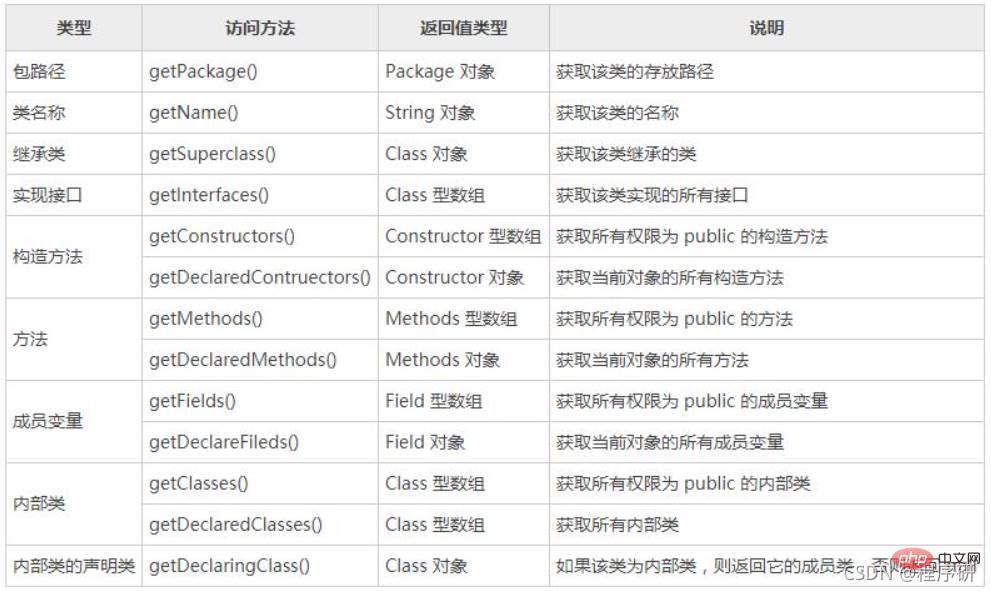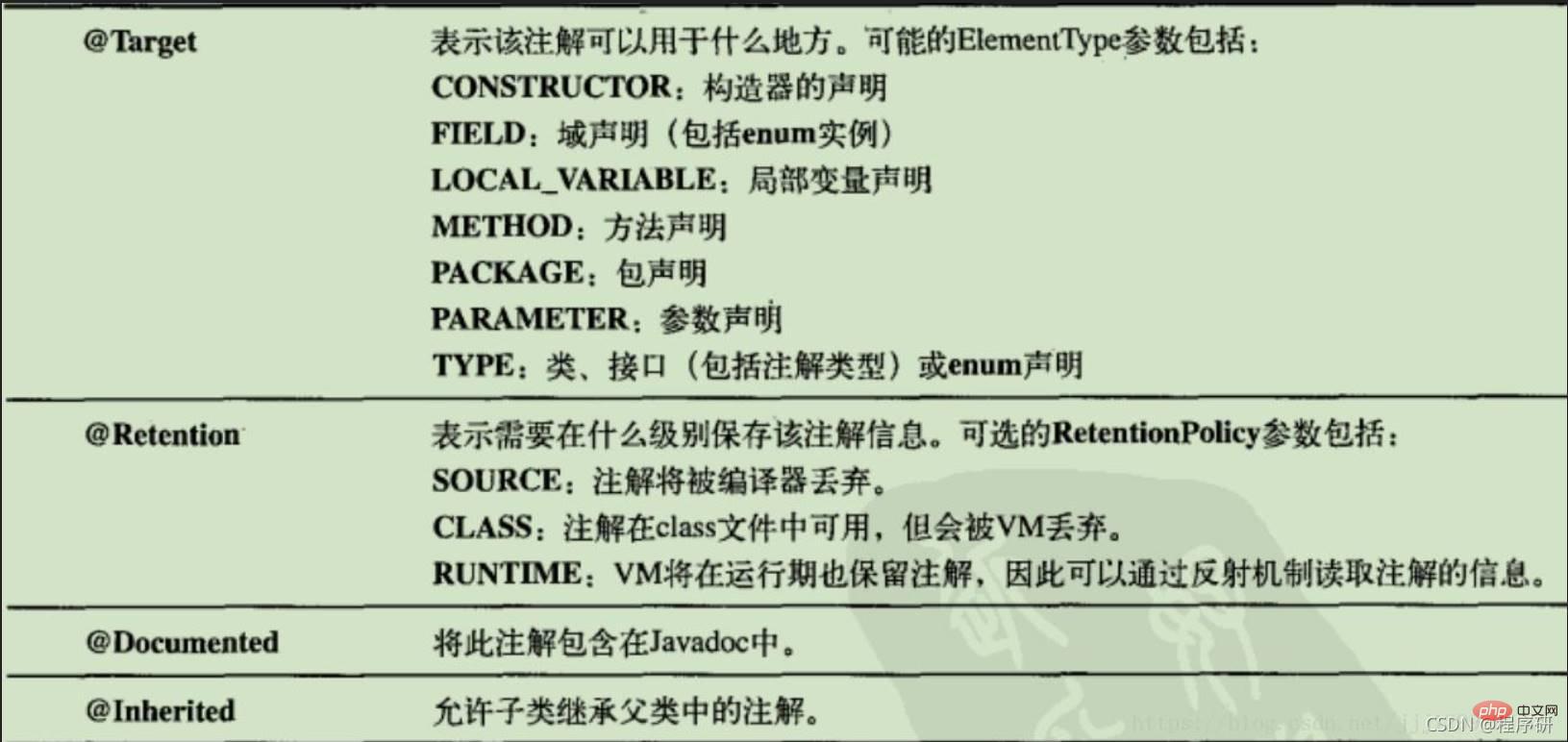ホームページ >Java >&#&チュートリアル >Javaリフレクションの分析例
Javaリフレクションの分析例
- WBOYWBOYWBOYWBOYWBOYWBOYWBOYWBOYWBOYWBOYWBOYWBOYWB転載
- 2023-04-29 21:10:051348ブラウズ
クラス textFieldC=tetxField.getClass(); //tetxField は JTextField クラス オブジェクトですリフレクション アクセシビリティの主な説明

getConstructors()
//Get public- ##getConstructor(Class>...parameterTypes )
//指定された public
- getDeclaredConstructors()
//すべてを取得
- getDeclaredConstructor(Class>...parameterTypes)
//指定されたメソッドを取得
Demo1クラスを作成し、String型のメンバ変数と3つのint型のメンバ変数を宣言し、 3つの構築方法を提供します。
package bao;
public class Demo1{
String s;
int i,i2,i3;
private Demo1() {
}
protected Demo1(String s,int i) {
this.s=s;
this.i=i;
}
public Demo1(String... strings)throws NumberFormatException{
if(0<strings.length) {
i=Integer.valueOf(strings[0]);
}
if(1<strings.length) {
i2=Integer.valueOf(strings[0]);
}
if(2<strings.length) {
i3=Integer.valueOf(strings[0]);
}
}
public void print() {
System.out.println("s="+s);
System.out.println("i="+i);
System.out.println("i2="+i2);
System.out.println("i3="+i3);
}
}このクラス内の Demo1 のすべてのコンストラクターへのリフレクティブ アクセスを実行するように Main クラスを作成し、コンストラクターが可変数のパラメーター、エントリ パラメーター、スローされる可能性のある例外の種類を許可するかどうかに関する情報を出力します。
package bao;
import java.lang.reflect.Constructor;
public class Main {
public static void main(String[] args) {
Demo1 demo=new Demo1("10","20","30");
Class<? extends Demo1>demoC=demo.getClass();
//获得所有构造方法
Constructor[] declaredConstryctors=demoC.getDeclaredConstructors();
for(int i=0;i<declaredConstryctors.length;i++) {
Constructor<?> constructor=declaredConstryctors[i];
System.out.println("查看是否允许带有可变数量的参数:"+constructor.isVarArgs());
System.out.println("该构造方法的入口参数类型依次为:");
Class[]parameterTypes=constructor.getParameterTypes(); //获取所有参数类型
for(int j=0;j<parameterTypes.length;j++) {
System.out.println(" "+parameterTypes[j]);
}
System.out.println("该构造方法的入口可能抛出异常类型为:");
//获取所有可能抛出的异常信息类型
Class[] exceptionTypes=constructor.getExceptionTypes();
for(int j=0;j<exceptionTypes.length;j++) {
System.out.println(" "+exceptionTypes[j]);
}
Demo1 example2=null;
while(example2==null) {
try {
if(i==2) {
example2=(Demo1)constructor.newInstance();
}else if(i==1) {
example2=(Demo1)constructor.newInstance("7",5);
}else {
Object[] parameters=new Object[] {new String[] {"100","200","300"}};
example2=(Demo1)constructor.newInstance(parameters);
}
}catch(Exception e){
System.out.println("在创建对象时抛出异常,下面执行setAccessible()方法");
constructor.setAccessible(true); //设置允许访问
}
}
if(example2!=null) {
example2.print();
System.out.println();
}
}
}
}
/*输出结果:
查看是否允许带有可变数量的参数:true
该构造方法的入口参数类型依次为:
class [Ljava.lang.String;
该构造方法的入口可能抛出异常类型为:
class java.lang.NumberFormatException
s=null
i=100
i2=100
i3=100
查看是否允许带有可变数量的参数:false
该构造方法的入口参数类型依次为:
class java.lang.String
int
该构造方法的入口可能抛出异常类型为:
s=7
i=5
i2=0
i3=0
查看是否允许带有可变数量的参数:false
该构造方法的入口参数类型依次为:
该构造方法的入口可能抛出异常类型为:
在创建对象时抛出异常,下面执行setAccessible()方法
s=null
i=0
i2=0
i3=0
*/2. メンバー変数へのアクセス
各 Field オブジェクトはメンバー変数を表し、対応するメンバー変数は Field オブジェクトを使用して操作できます。
- getFields()
- getField(文字列名)
- getDeclaredFields()
- getDeclaredField(String name)
- Demo1 クラスを作成し、int、fioat、boolean、String 型のメンバー変数を順番に宣言し、異なるアクセスを設定します権利。
package bao;
public class Demo1{
int i;
public float f;
protected boolean b;
private String s;
}リフレクションを通じて Demo1 クラス内のすべてのメンバー変数にアクセスし、メンバー変数の名前と型情報を出力します。
package bao;
import java.lang.reflect.Field;
public class Main {
public static void main(String[] args) {
Demo1 demo=new Demo1();
Class demoC=demo.getClass();
//获得所有成员变量
Field[] declaredField=demoC.getDeclaredFields();
for(int i=0;i<declaredField.length;i++) {
Field field=declaredField[i];
System.out.println("名称为:"+field.getName()); //获取成员变量名称
Class fieldType=field.getType(); ///获取成员变量类型
System.out.println("类型为:"+fieldType);
boolean isTurn=true;
while(isTurn) {
try {
isTurn=false;
System.out.println("修改前的值为:"+field.get(demo));
if(fieldType.equals(int.class)) { //判断成员变量的类型是否为int类型
System.out.println("利用方法setInt()修改成员变量的值");
field.setInt(demo, 168); //为int类型成员变量赋值
}else if(fieldType.equals(float.class)){ //判断成员变量的类型是否为float类型
System.out.println("利用方法 setFloat()修改成员变量的值");
field.setFloat(demo, 99.9F); //为float类型成员变量赋值
}else if(fieldType.equals(boolean.class)){ //判断成员变量的类型是否为boolean类型
System.out.println("利用方法 setBoolean()修改成员变量的值");
field.setBoolean(demo, true); //为boolean类型成员变量赋值
}else {
System.out.println("利用方法 set()修改成员变量的值");
field.set(demo, "MWQ"); //可以为各种类型的成员变量赋值
}
//获得成员变量值
System.out.println("修改后的值为:"+field.get(demo));
}catch(Exception e) {
System.out.println("在设置成员变量值时抛出异常,"+"下面执行setAccesssible()方法!");
field.setAccessible(true); //设置为允许访问
isTurn=true;
}
}
System.out.println();
}
}
}/*出力結果: 名前: i型: int
3. アクセス メソッド
変更前の値: 0
setInt()メソッドを使用します。メンバー変数を変更するには 値
変更後の値: 168
名前: f
型: float
変更前の値: 0.0
setFloat()メソッドを使用します。メンバー変数の値を変更するには
変更された値は: 99.9
名前は: b
型は: boolean
変更前の値は: false
メソッド setBoolean( ) メンバー変数の値を変更します
変更後値は: true
名前は: s
型は: class java.lang.String
メンバ変数の値を指定するには、以下の setAccesssible() メソッドを実行してください。
変更前の値: null
メソッド set() を使用してメンバー変数の値を変更します
変更後の値: MWQ
*/
各 Method オブジェクトはメソッドを表し、対応するメソッドは Method オブジェクトを使用して操作できます。
#getMethods()##getMethod(文字列名, Class>...parameterTypes)
-
getDeclaredMethods()
getDeclaredMethod(String name, Class>...parameterTypes)
-
Demo1 クラスを作成します。代表的な方法を4つ書きます。
package bao; public class Demo1{ static void staitcMethod() { System.out.println("执行staitcMethod()方法"); } public int publicMethod(int i) { System.out.println("执行publicMethod()方法"); return i*100; } protected int protectedMethod(String s,int i)throws NumberFormatException { System.out.println("执行protectedMethod()方法"); return Integer.valueOf(s)+i; } private String privateMethod(String...strings) { System.out.println("执行privateMethod()方法"); StringBuffer stringBuffer=new StringBuffer(); for(int i=0;i<stringBuffer.length();i++) { stringBuffer.append(strings[i]); } return stringBuffer.toString(); } } Reflection は、Demm1 クラス内のすべてのメソッドにアクセスし、メソッド名、エントリパラメータの型、戻り値の型などの情報を出力します。
package bao;
import java.lang.reflect.Field;
import java.lang.reflect.Method;
public class Main {
public static void main(String[] args) {
Demo1 demo = new Demo1();
Class demoC = demo.getClass();
// 获得所有方法
Method[] declaredMethods = demoC.getDeclaredMethods();
for (int i = 0; i < declaredMethods.length; i++) {
Method method = declaredMethods[i]; // 遍历方法
System.out.println("名称为:" + method.getName()); // 获得方法名称
System.out.println("是否允许带有可变数量的参数:" + method.isVarArgs());
System.out.println("入口参数类型依次为:");
// 获得所有参数类型
Class[] parameterTypes = method.getParameterTypes();
for (int j = 0; j < parameterTypes.length; j++) {
System.out.println(" " + parameterTypes[j]);
}
// 获得方法返回值类型
System.out.println("返回值类型为:" + method.getReturnType());
System.out.println("可能抛出的异常类型有:");
// 获得方法可能抛出的所有异常类型
Class[] exceptionTypes = method.getExceptionTypes();
for (int j = 0; j < exceptionTypes.length; j++) {
System.out.println(" " + exceptionTypes[j]);
}
boolean isTurn = true;
while (isTurn) {
try {
isTurn = false;
if("staitcMethod".equals(method.getName())) {
method.invoke(demo); // 执行没有入口参数的方法
}else if("publicMethod".equals(method.getName())) {
System.out.println("返回值为:"+ method.invoke(demo, 168)); // 执行方法
}else if("protectedMethod".equals(method.getName())) {
System.out.println("返回值为:"+ method.invoke(demo, "7", 5)); // 执行方法
}else {
Object[] parameters = new Object[] { new String[] {"M", "W", "Q" } }; // 定义二维数组
System.out.println("返回值为:"+ method.invoke(demo, parameters));
}
}catch(Exception e) {
System.out.println("在执行方法时抛出异常,"
+ "下面执行setAccessible()方法!");
method.setAccessible(true); // 设置为允许访问
isTurn = true;
}
}
System.out.println();
}
}
}/*出力結果: 名前: publicMethod
可変数のパラメーターが許可されるかどうか: falseエントリ パラメーターの型:int
1. アノテーション タイプを定義します
戻り値の型: int
スローされる可能性のある例外の型
publicMethod() メソッドを実行します
戻り値は 16800
名前は staitcMethod
可変数のパラメータが許可されるかどうか:false
エントリ パラメータのタイプは次のとおりです。
Return 値のタイプは次のとおりです: void
スローされる可能性のある例外のタイプは次のとおりです:
staitcMethod() メソッドを実行します
名前は次のとおりです: protectedMethod
可変数のパラメータが許可されるかどうか: false
エントリ パラメータの型は次のとおりです:
class java.lang.String
int
戻り値の型は次のとおりです: int
スローされる可能性のある例外の型は次のとおりです:
class java.lang.NumberFormatException
Execution protectedMethod() メソッド
戻り値: 12
名前:privateMethod
可変数のパラメータが許可されるかどうか: true
エントリ パラメータのタイプ
class [Ljava.lang .String;
戻り値の型は次のとおりです: class java.lang.String
スローされる可能性のある例外の型は次のとおりです:
メソッドの実行時に例外がスローされます, 以下の setAccessible() メソッドを実行してください。
privateMethod() メソッドを実行します
戻り値は:
*/
2. アノテーション関数を使用します
アノテーション タイプを定義する場合、インターフェイスの定義に使用されるインターフェイス キーワードも使用する必要がありますが、インターフェイス キーワードの前に「@」記号を追加する必要があります。つまり、アノテーション タイプを定義するキーワードは@interface. このキーワードの暗黙の意味 java.lang.annotation.Annotation インターフェースを継承することを意味します。
public @interface NoMemberAnnotation{String value();}
##@interface: 宣言しますキーワード。
NoMemberAnnotation: アノテーション名。
String: メンバーのタイプ。
値: メンバー名。

定义并使用Annotation类型
①定义Annotation类型@Constructor_Annotation的有效范围为运行时加载Annotation到JVM中。
package annotationbao;
import java.lang.annotation.ElementType;
import java.lang.annotation.Retention;
import java.lang.annotation.RetentionPolicy;
import java.lang.annotation.Target;
@Target(ElementType.CONSTRUCTOR) // 用于构造方法
@Retention(RetentionPolicy.RUNTIME) // 在运行时加载Annotation到JVM中
public @interface Constructor_Annotation{
String value() default "默认构造方法"; // 定义一个具有默认值的String型成员
}②定义一个来注释字段、方法和参数的Annotation类型@Field_Method_Parameter_Annotation的有效范围为运行时加载Annotation到JVM中
package annotationbao;
import java.lang.annotation.ElementType;
import java.lang.annotation.Retention;
import java.lang.annotation.RetentionPolicy;
import java.lang.annotation.Target;
@Target({ElementType.FIELD,ElementType.METHOD,ElementType.PARAMETER}) // 用于字段、方法和参数
@Retention(RetentionPolicy.RUNTIME) // 在运行时加载Annotation到JVM中
public @interface Field_Method_Parameter_Annotation{
String descrblic(); // 定义一个没有默认值的String型成员
Class type() default void.class; // 定义一个具有默认值的Class型成员
}③编写一个Record类,在该类中运用前面定义Annotation类型的@Constructor_Annotation和@Field_Method_Parameter_Annotation对构造方法、字段、方法和参数进行注释。
package annotationbao;
public class Record {
@Field_Method_Parameter_Annotation(describe = "编号", type = int.class)
int id;
@Field_Method_Parameter_Annotation(describe = "姓名", type = String.class)
String name;
@Constructor_Annotation()
public Record() {
}
@Constructor_Annotation("立即初始化构造方法")
public Record(
@Field_Method_Parameter_Annotation(describe = "编号", type = int.class)
int id,
@Field_Method_Parameter_Annotation(describe = "姓名", type = String.class)
String name) {
this.id = id;
this.name = name;
}
@Field_Method_Parameter_Annotation(describe = "获得编号", type = int.class)
public int getId() {
return id;
}
@Field_Method_Parameter_Annotation(describe = "设置编号")
public void setId(
@Field_Method_Parameter_Annotation(describe = "编号", type = int.class)int id) {
this.id = id;
}
@Field_Method_Parameter_Annotation(describe = "获得姓名", type = String.class)
public String getName() {
return name;
}
@Field_Method_Parameter_Annotation(describe = "设置姓名")
public void setName(
@Field_Method_Parameter_Annotation(describe = "姓名", type = String.class)String name) {
this.name = name;
}
}2、访问Annotation信息
如果在定义Annotation类型时将@Retention设置为RetentionPolicy.RUNTIME,那么在运行程序时通过反射就可以获取到相关的Annotation信息,如获取构造方法、字段和方法的Annotation信息。
联合以上的定义并使用Annotation类型,通过反射访问Record类中的Annotation信息。
package annotationbao;
import java.lang.annotation.*;
import java.lang.reflect.*;
public class Main_05 {
public static void main(String[] args) {
Class recordC = null;
try {
recordC = Class.forName("Record");
} catch (ClassNotFoundException e) {
e.printStackTrace();
}
System.out.println("------ 构造方法的描述如下 ------");
Constructor[] declaredConstructors = recordC
.getDeclaredConstructors(); // 获得所有构造方法
for (int i = 0; i < declaredConstructors.length; i++) {
Constructor constructor = declaredConstructors[i]; // 遍历构造方法
// 查看是否具有指定类型的注释
if (constructor
.isAnnotationPresent(Constructor_Annotation.class)) {
// 获得指定类型的注释
Constructor_Annotation ca = (Constructor_Annotation) constructor
.getAnnotation(Constructor_Annotation.class);
System.out.println(ca.value()); // 获得注释信息
}
Annotation[][] parameterAnnotations = constructor
.getParameterAnnotations(); // 获得参数的注释
for (int j = 0; j < parameterAnnotations.length; j++) {
// 获得指定参数注释的长度
int length = parameterAnnotations[j].length;
if (length == 0) // 如果长度为0则表示没有为该参数添加注释
System.out.println(" 未添加Annotation的参数");
else
for (int k = 0; k < length; k++) {
// 获得参数的注释
Field_Method_Parameter_Annotation pa = (Field_Method_Parameter_Annotation) parameterAnnotations[j][k];
System.out.print(" " + pa.describe()); // 获得参数描述
System.out.println(" " + pa.type()); // 获得参数类型
}
}
System.out.println();
}
System.out.println();
System.out.println("-------- 字段的描述如下 --------");
Field[] declaredFields = recordC.getDeclaredFields(); // 获得所有字段
for (int i = 0; i < declaredFields.length; i++) {
Field field = declaredFields[i]; // 遍历字段
// 查看是否具有指定类型的注释
if (field
.isAnnotationPresent(Field_Method_Parameter_Annotation.class)) {
// 获得指定类型的注释
Field_Method_Parameter_Annotation fa = field
.getAnnotation(Field_Method_Parameter_Annotation.class);
System.out.print(" " + fa.describe()); // 获得字段的描述
System.out.println(" " + fa.type()); // 获得字段的类型
}
}
System.out.println();
System.out.println("-------- 方法的描述如下 --------");
Method[] methods = recordC.getDeclaredMethods(); // 获得所有方法
for (int i = 0; i < methods.length; i++) {
Method method = methods[i]; // 遍历方法
// 查看是否具有指定类型的注释
if (method
.isAnnotationPresent(Field_Method_Parameter_Annotation.class)) {
// 获得指定类型的注释
Field_Method_Parameter_Annotation ma = method
.getAnnotation(Field_Method_Parameter_Annotation.class);
System.out.println(ma.describe()); // 获得方法的描述
System.out.println(ma.type()); // 获得方法的返回值类型
}
Annotation[][] parameterAnnotations = method
.getParameterAnnotations(); // 获得参数的注释
for (int j = 0; j < parameterAnnotations.length; j++) {
int length = parameterAnnotations[j].length; // 获得指定参数注释的长度
if (length == 0) // 如果长度为0表示没有为该参数添加注释
System.out.println(" 未添加Annotation的参数");
else
for (int k = 0; k < length; k++) {
// 获得指定类型的注释
Field_Method_Parameter_Annotation pa = (Field_Method_Parameter_Annotation) parameterAnnotations[j][k];
System.out.print(" " + pa.describe()); // 获得参数的描述
System.out.println(" " + pa.type()); // 获得参数的类型
}
}
System.out.println();
}
}
}/*输出结果:
------ 构造方法的描述如下 ------
默认构造方法
立即初始化构造方法
编号 int
姓名 class java.lang.String
-------- 字段的描述如下 --------
编号 int
姓名 class java.lang.String
-------- 方法的描述如下 --------
获得姓名
class java.lang.String
设置姓名
void
姓名 class java.lang.String
获得编号
int
设置编号
void
编号 int
*/
以上がJavaリフレクションの分析例の詳細内容です。詳細については、PHP 中国語 Web サイトの他の関連記事を参照してください。

